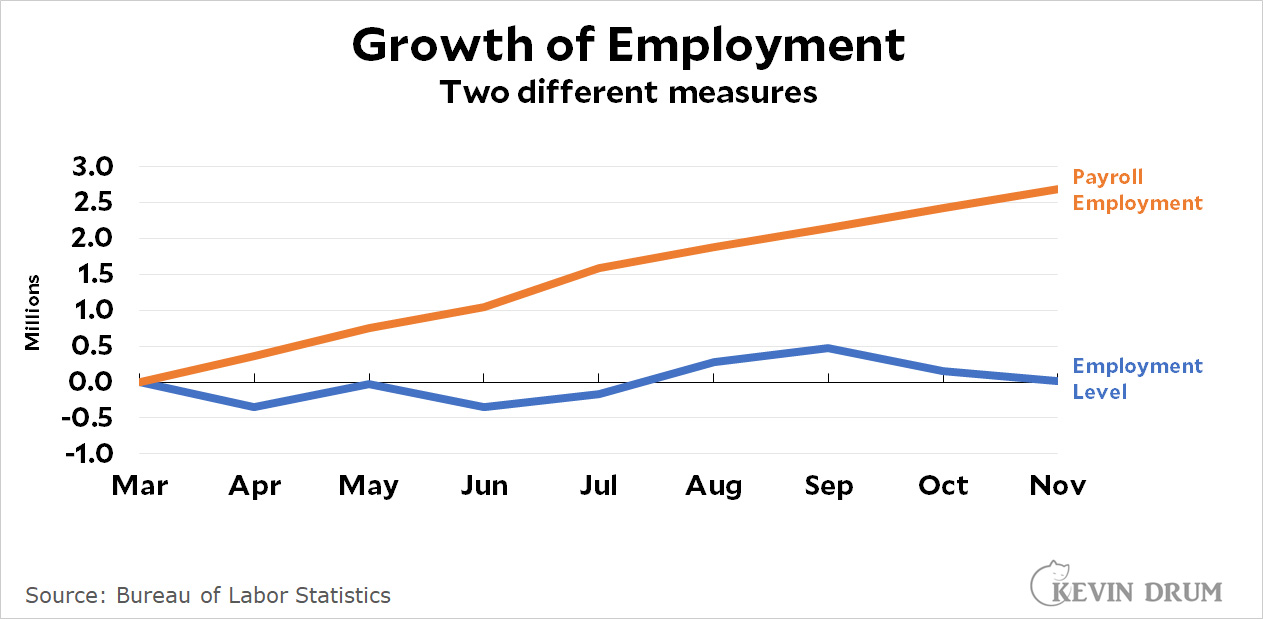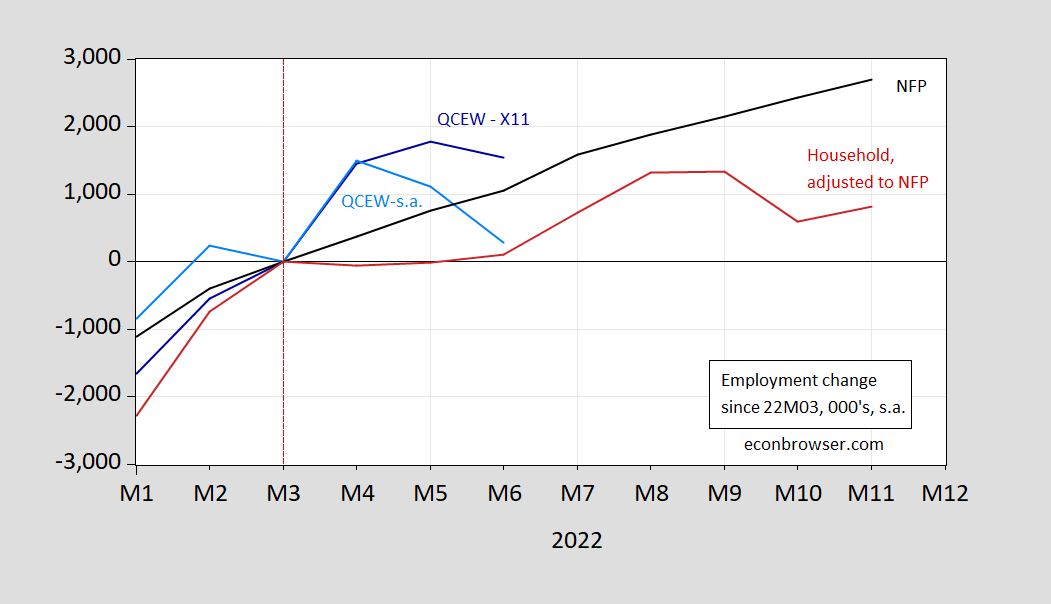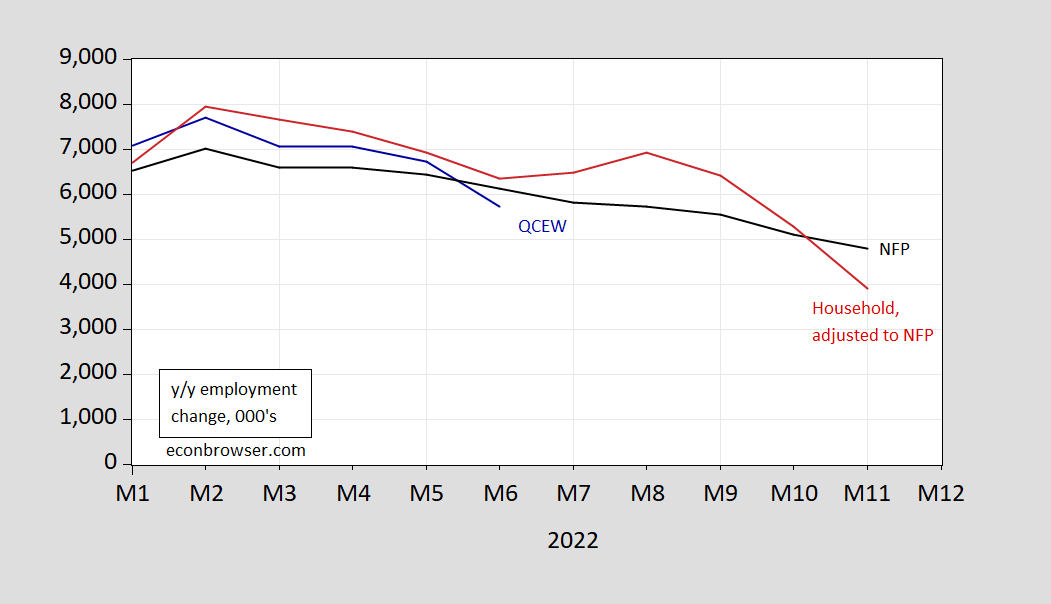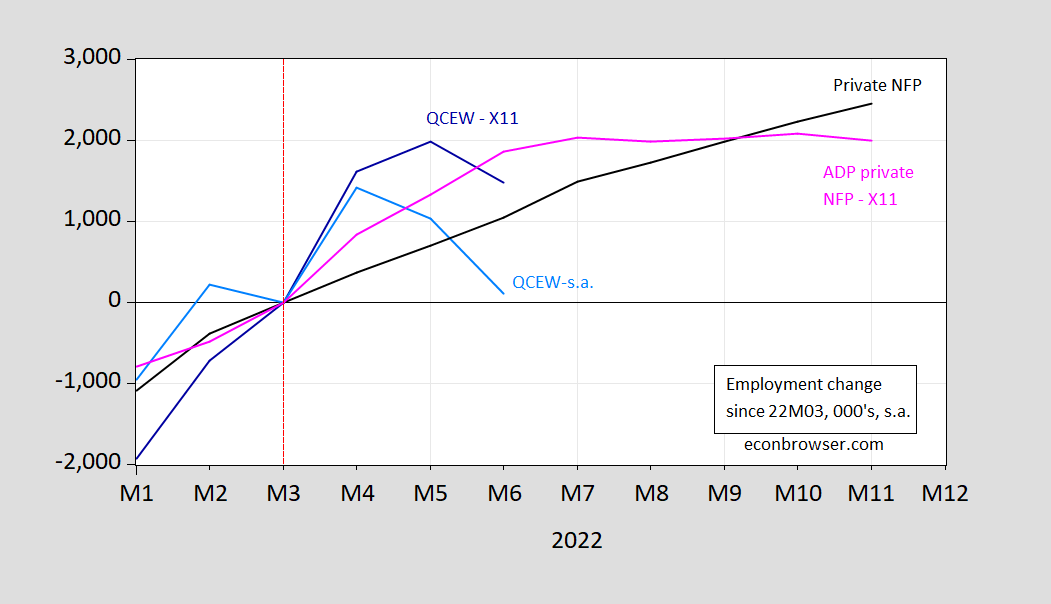That’s the proposition forwarded by Kevin Drum at Jabberwocking. Verbatim:
So: have we actually created 2.5 million new jobs since March? I’m unsure I consider that.
The graph he posted summarizes his argument succinctly:
Supply: Drum (2022).
The stylized truth is that the family sequence provides nearly nothing to the knowledge contained within the institution sequence relating to the cyclical habits or employment, a degree made by practictioners (see Furman, 2016, or CEA, 2017). Nevertheless, the opportunity of mismeasurement, notably in these instances, stays. Some suggestion of mismeasurement is supplied by the habits of not-seasonally-adjusted nonfarm payroll (NFP) employment, and complete employment lined by the Quarterly Census of Employment and Wages (QCEW). For quite a lot of causes referring to workers protection, the numbers differ, however the total developments ought to present some perception.
Determine 1: Log ratio of nsa NFP to QCEW (blue), and 2001-19 common (crimson dashed line). NBER outlined peak-to-trough recession dates shaded grey. Supply: BLS through FRED, BLS, NBER, and creator’s calculations.
In 2021 and the primary half of 2022, NFP has been under what the historic relationship with QCEW would recommend.
Whereas the institution survey is precisely that — a survey –, the QCEW is a census which ought to in precept catch all lined employment, by the use of tax data, and so forth. This knowledge, amongst others, is used to benchmark the institution sequence. The final preliminary benchmark utilized to March 2022 (however not has but been included into the official sequence — I do that on this publish). Discover that in Determine 2, the ratio dropped precipitously in early 2022, and jumped again up in June. This recommend to me that as of June, the nsa NFP sequence was not manner off. Now, the QCEW lags significantly (knowledge by June was printed on November 22), so we are able to’t actually use the QCEW to make judgments on knowledge from July by November.
GIven this, what make of web employment development — measured in several methods — since March 2022 (when the final benchmark month was)? Along with the official BLS institution NFP sequence, the QCEW sequence (seasonally adjusted by me) and the family sequence adjusted to the NFP idea are proven in Determine 2.
Determine 2: Change in employment from NFP (black), QCEW adjusted utilizing Census X-11 seasonal adjustment by creator (darkish blue), QCEW utilizing multiplicative transferring common variations by creator (sky blue), and utilizing family employment sequence adjusted to NFP idea (crimson), all in 1000’s, relative to 2022M03. Supply: BLS through FRED, BLS, BLS, and creator’s calculations.
The analysis sequence on family employment adjusted to NFP idea shouldn’t be an official sequence, and is described right here. A caveat: provided that the family employment sequence is predicated on a comparatively small pattern, the variability related to it — and therefore by extension its spinoff sequence — goes to be comparatively giant.
By way of June, it’s unclear whether or not NFP undercounts or overcounts relative to the QCEW quantity given the differing outcomes supplied by the seasonal adjustment course of. The adjusted family sequence signifies that by November, solely about 800 thousand NFP jobs had been created vs. 2700 thousand from the official NFP sequence.
One approach to get across the seasonal adjustment issues (which have been compounded by the acute drop related to the pandemic) is to have a look at 12 month modifications. This clearly downweights latest developments, however no less than we get a have a look at the developments.
Determine 3: 12 month change in employment from not seasonally adjusted NFP (black), QCEW (darkish blue), and family employment sequence adjusted to NFP idea (crimson), all in 1000’s, relative to 2022M03. Supply: BLS through FRED, BLS, BLS, and creator’s calculations.
All three sequence match up fairly properly by 2022M06. Studying as much as 2022M11, each the NFP and adjusted family sequence present declines. Which one to consider? As famous earlier, Furman, 2016 and CEA, 2017 place nearly complete weight on the institution sequence. A extra formal evaluation exhibiting nearly complete weight on preliminary institution sequence for actual time evaluation is supplied by Goto, Jacobs, Sinclair and van Norder (2021). (As an apart, if I have a look at the ultimate knowledge for NFP and the adjusted family sequence, statistically the adjusted family sequence appears to reply to gaps between the 2 sequence, whereas the NFP sequence doesn’t; formally, the adjusted sequence responds to an error correction time period.)
So, for now, whereas I see it as an open query what (NFP) employment development is, I feel (1) it’s possible optimistic, and (2) possible declining in tempo.
Addendum:
Macroduck suggests evaluating personal NFP utilizing ADP knowledge. I repeat the above evaluation, substituting ADP sequence for the family sequence.
Determine 3: Change in personal employment from NFP (black), personal QCEW adjusted utilizing Census X-11 seasonal adjustment by creator (darkish blue), personal QCEW utilizing multiplicative transferring common variations by creator (sky blue), and ADP personal NFP (pink), all in 1000’s, relative to 2022M03. Supply: BLS through FRED, BLS, BLS, and creator’s calculations.
Determine 3: 12 month change in employment from not seasonally adjusted NFP (black), QCEW (darkish blue), and family employment sequence adjusted to NFP idea (crimson), all in 1000’s, relative to 2022M03. Supply: BLS through FRED, BLS, BLS, and creator’s calculations.
The ADP sequence and the BLS CES sequence match fairly properly, with the ADP sequence exhibiting a quicker deceleration. ADP reveals about 2 million new personal sector jobs vs. 2.45 for the BLS sequence.










